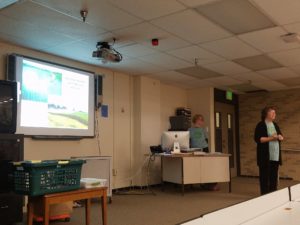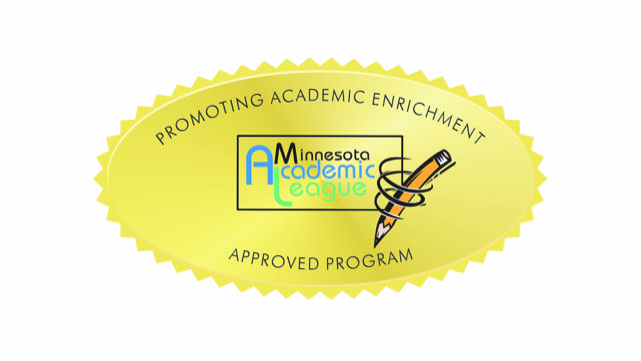On a warm Thursday afternoon, 32 students and teachers from the Youth Energy Summit (YES!) team, and three science classes at New Ulm Middle School attended the recent Composting Presentation at New Ulm Middle School on May 4, 2017. This presentation focused on the topic of composting, giving examples of how and why to do it.
Betty Winkworth and Jane Dow from Mankato Zero Waste provided a bounty of information on what composting is and why we should do it. The focus of Zero Waste is to educate community members and provide an easy way for them to reduce their waste. Their main topic of interest is where food scraps go. “Composting is the way nature has done it since the beginning of time” said Betty, so it makes sense that we continue utilizing this natural process.
When in a landfill, all materials get packed together under the weight of incoming trash. This leads to a situation where organic materials begin breaking down anaerobically, or without oxygen. The byproduct of this process is methane gas, which is a detrimental addition to the atmosphere as it is one of the most potent greenhouse gasses. By putting organic material in a composting facility, piles are turned and oxygen is introduced, allowing material breaking down aerobically without producing methane gas. One of the benefits of using commercial composting sites is that more items are accepted than would be in a small scale, backyard pile. With the large volume of ingredients, commercial site piles are able to reach a higher internal temperature, allowing for better material sanitation.
The ladies described multiple ways of collecting the food scraps in homes, including using an ice cream bucket in the house and transferring it to a larger bucket outside, freezing it, and more. When the scraps have accumulated, residents take it to centrally localized dumpsters in the three participating towns, which are then taken to Midwest Recycling Solutions at the MFS Farm in Good Thunder.
Homeowners are not the  only people benefiting from this service. Multiple businesses in the Mankato area are using compostable utensils and dishes and are composting their food scraps. Sending these items to a compost site instead of placing them in the trash actually people saves money. When trash pickup is charged by weight, a reduction of the heavy food waste can make a large impact on the costTo make good compost, there needs to be the correct balance of nitrogen and carbon. The nitrogen source, or green, comes from the dumpsters brought in from the local communities. Carbon, or brown, is added by mixing in leaves or wood chips into the mix. Accurate proportions of greens and browns allow the material to break down properly, creating compost. The piles are tuned every week and in 4 to 6 months, the pile has become usable compost. The material is lab tested to ensure safety and is then sold through various outlets. Using compost is very beneficial to the land as it is full of nutrients, reducing the need for chemical application, and it holds water more efficiently, leading to a reduction of soil erosion and an increase in available water for plants.
only people benefiting from this service. Multiple businesses in the Mankato area are using compostable utensils and dishes and are composting their food scraps. Sending these items to a compost site instead of placing them in the trash actually people saves money. When trash pickup is charged by weight, a reduction of the heavy food waste can make a large impact on the costTo make good compost, there needs to be the correct balance of nitrogen and carbon. The nitrogen source, or green, comes from the dumpsters brought in from the local communities. Carbon, or brown, is added by mixing in leaves or wood chips into the mix. Accurate proportions of greens and browns allow the material to break down properly, creating compost. The piles are tuned every week and in 4 to 6 months, the pile has become usable compost. The material is lab tested to ensure safety and is then sold through various outlets. Using compost is very beneficial to the land as it is full of nutrients, reducing the need for chemical application, and it holds water more efficiently, leading to a reduction of soil erosion and an increase in available water for plants.
Students walked away with an increased knowledge of composting and will be able to use this information and have the capability to expand their current composting system, their YES! worm bins. Everyone in attendance was inspired to be more conscious about purchases and ultimately what they do with their waste.
